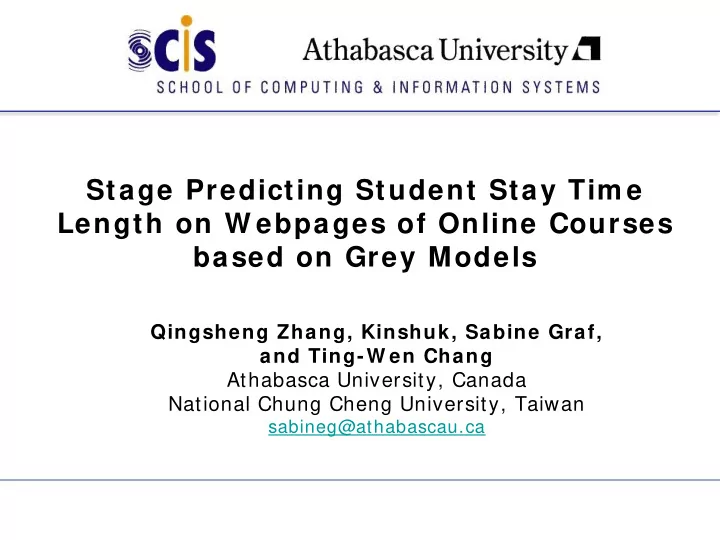

Stage Predicting Student Stay Tim e Length on W ebpages of Online Courses based on Grey Models Qingsheng Zhang, Kinshuk, Sabine Graf, and Ting-W en Chang Athabasca University, Canada National Chung Cheng University, Taiwan sabineg@athabascau.ca
Motivation Student Modelling: try to get various information about a student More and more research is done on automatic student modelling Automatic student modelling means to infer students’ characteristic (e.g., learning styles, cognitive abilities, etc.) from their behaviour in a online course 2
Motivation One of the most often used variables for automatic student modelling is the time that students spent on certain learning objects (e.g., content). However, time is a problematic variable since it can include a lot of noise (e.g., student is doing something else, last learning object of the learning session, etc.) In this paper, we look into the prediction of stay time length of students using stage prediction, power law, and grey models 3
Research Question and Contributions How to predict the stay time length of students on content? An approach for such prediction can help in Filtering noise from real data and therefore, provide more accurate stay time length data improves automatic student modelling improves learner analytics Compare actual length with predicted length and response to significant differences ( content object might be too difficult or too trivial) improves course design 4
Looking into Power Law Power Law is a specific relationship between two quantities: P(x) = c * x -k Many relationships are based on this formula In the educational domain, this ranges from short term perceptional tasks to team-based long term tasks (Ritter and Schooler, 2001), where the power law describes the relationship between practices and performance For more complex skills, decomposition of the skills in each underlying skill again shows power law relationships (Kenneth and Santosh, 2004) 5
Data Data from an online course We looked only into data about content 91,084 learning events from 459 students Threshold for low noise: 2 sec. Threshold for high noise: 300, 600, 900, 1200, 1800 sec. More than 50,000 data are used for testing after filtering 6
Experiment Predicting data using power law and two grey models: GM (1, 1) for exponential type sequences Verhulst for sequences with saturated trend Prediction is based on the 3 most recent history data Subsequence of 3 data is used to predict the next one Shift to the next subsequence of 3 data and predict the next one Etc. 7
Experiment Compare predicted data with actual data Considered new knowledge concepts by observing the ratio between actual data and predicted data If this ration exceeds a certain threshold assume that the student starts learning a new knowledge concept using next 3 data for constructing a new predicting model 8
Results Number of Ratio NLV(s) NHV(s) AMMRE (% ) predicted points 1 2 600 89.51 104 2 2 600 38.67 4,552 3 2 600 59.00 5,693 4 2 600 76.96 5,773 5 2 600 92.43 5,629 6 2 600 104.84 5,417 7 2 600 118.40 5,188 Predicted Ratio NLV(s) NHV(s) AMMRE (% ) points numbers 1 2 900 90.82 107 2 2 900 38.36 4,548 3 2 900 58.99 5,720 4 2 900 77.75 5,911 5 2 900 93.06 5,802 6 2 900 105.40 5,612 7 2 900 119.21 5,399 9
Conclusions Relative error of 38% is not too bad (e.g., actual value is 1 minute, predicted value is 1: 20) Results show that using power law and grey models can to a certain extend predict stay time of learners on content pages Future research will deal with refining our approach (e.g., by looking into other predictive models, considering complexity of content pages, etc.) 10
Recommend
More recommend